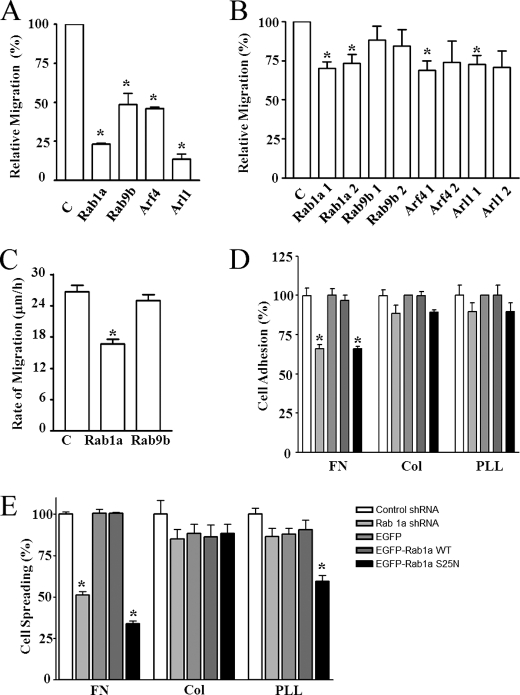FIGURE 1.
Identification of Rab1a as a novel regulatory protein for cell migration. Drosophila S2 cells (A) or HEK293 cells (B) were treated with siRNA targeting fly orthologs of Rab1a, Rab9b, Arf4, or Arl1 (A) or were transiently transfected with lentiviral plasmids encoding shRNA for these human small GTPases (two for each) (B) as indicated. Three days after, the cells were subjected to the Transwell migration assays as described under “Experimental Procedures.” The means ± S.E. of cell migration were determined from three independent experiments and normalized to those of cells treated with control siRNA (C). *, p < 0.05 in comparison with the value from control siRNA/shRNA-treated cells. C, NIH 3T3 cells were transiently transfected with lentiviral plasmids encoding GFP and shRNA for Rab1a, Rab9b, or a control sequence as indicated. Two days after transfection, a wound was generated in the cell monolayer to induce cell migration. The rate of cell migration was measured by quantifying the total distance that the positively transfected cells (GFP+) moved from the edge of the wound toward the center of the wound in 4 h. The mean ± S.E. from three independent experiments is shown. *, p < 0.01 in comparison with the value from cells transfected with control shRNA. D and E, NIH 3T3 cells were transiently transfected with lentiviral plasmids encoding shRNA for Rab1a or a control sequence or by pEGFP plasmids encoding Rab1a, the S25N mutant, or enhanced GFP (EGFP) as a control as indicated. Two days after transfection, the cells were suspended and replated on dishes coated with fibronectins (FN), collagen I (Col), or poly-l-lysine (PLL) for 1 h. The mean ± S.E. of cell adhesion (D) or spreading (E) from at least three experiments is shown. *, p < 0.05 in comparison with the value from cells transfected with control shRNA.

